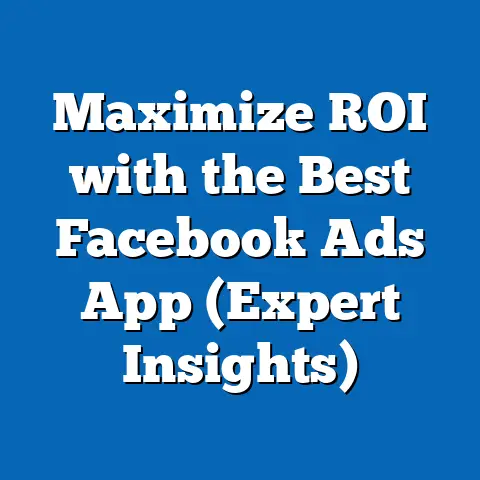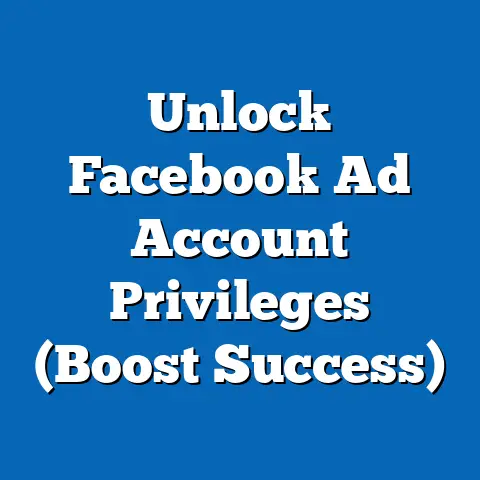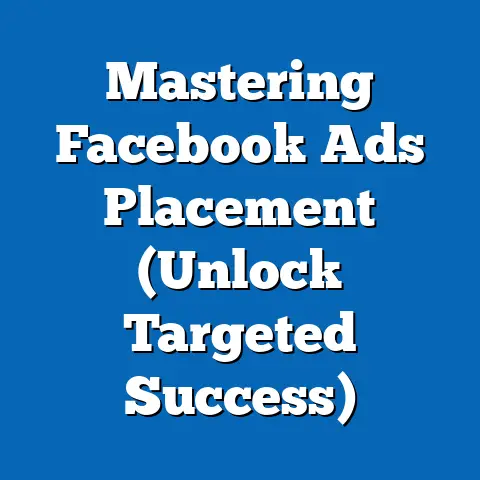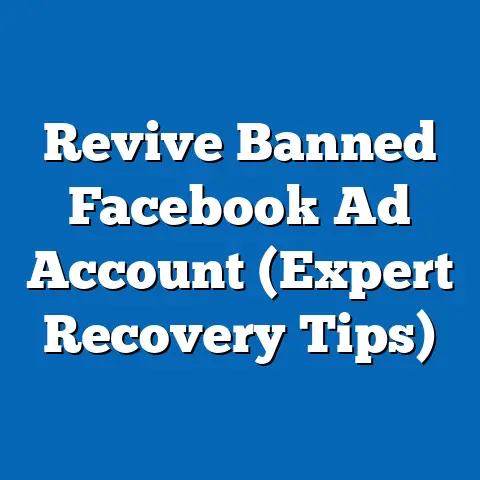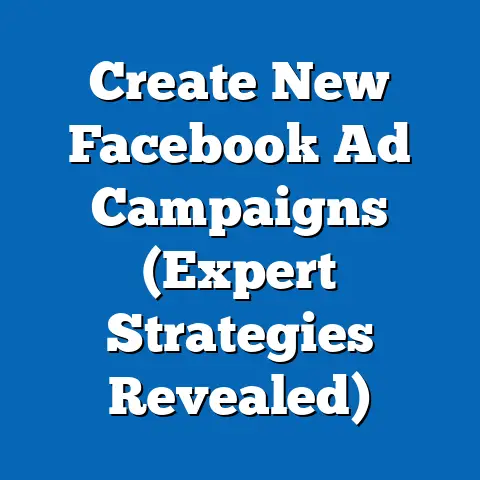Optimize Facebook Ad Lengths (Proven Strategies Unveiled)
Facebook advertising has become an integral part of the digital marketing landscape. Since its inception, the platform has evolved dramatically, introducing new ad formats, sophisticated targeting options, and advanced analytics tools. As a digital marketing specialist, I’ve witnessed firsthand how these changes have revolutionized the way businesses connect with their audiences.
I remember when Facebook ads were simpler – a basic image and a short text blurb. Now, we have immersive experiences, video ads that tell stories, and complex carousel ads that showcase multiple products. This evolution means marketers need to be more strategic than ever, especially when it comes to something as seemingly simple as ad length.
In today’s fast-paced digital world, capturing and retaining audience attention is paramount. One of the most critical, yet often overlooked, elements of a successful Facebook ad campaign is the length of the ad itself. Think about it: users are bombarded with content every time they open their Facebook feed. If your ad is too long and rambling, they’ll scroll right past it. Too short, and you risk not conveying your message effectively.
Key Takeaways:
- Ad length matters: It directly impacts engagement, click-through rates, and overall campaign performance.
- Context is crucial: The optimal ad length varies depending on the ad format, target audience, and campaign objectives.
- Testing is essential: A/B testing different ad lengths is the best way to identify what works for your specific audience.
- Conciseness is key: Focus on delivering your message in the most efficient and impactful way possible.
Section 1: Understanding Facebook Ad Lengths
When I talk about “ad length” in the context of Facebook ads, I’m referring to a few different things. It’s not just about the number of characters in your text; it’s a holistic concept that encompasses:
- Text Length: The character limits for headlines, primary text, and descriptions.
- Video Duration: The length of your video ad, which can range from a few seconds to several minutes.
- Image Dimensions: The size and aspect ratio of your images, which can impact how much text you can overlay.
Understanding these elements is crucial because each plays a role in how your ad is perceived and how effectively it communicates your message.
The Psychological Impact of Ad Length
Think about your own experience scrolling through Facebook. What makes you stop? What makes you keep scrolling? Our attention spans are shrinking, and we’re constantly bombarded with information. Studies have shown that people make snap judgments about content within seconds, and that first impression can make or break your ad.
I’ve seen this play out time and time again in my own campaigns. A lengthy, text-heavy ad will often get ignored, while a concise, visually appealing ad will stop people in their tracks. This isn’t just anecdotal; research supports the idea that shorter, more digestible content tends to perform better in social media environments.
Why? Because:
- Cognitive Load: Long ads require more mental effort to process, which can lead to fatigue and disengagement.
- Time Constraints: People are busy and don’t want to spend a lot of time reading or watching ads.
- Mobile-First World: Most Facebook users are on mobile devices, where screen real estate is limited, and shorter content is easier to consume.
Different Ad Types and Recommended Lengths
Facebook offers a variety of ad formats, each with its own recommended lengths and specifications. Here’s a breakdown:
- Single Image Ads:
- Headline: Up to 25 characters
- Primary Text: Up to 125 characters (though longer text can be used, it may get truncated)
- Description: Up to 30 characters (optional)
- Image Size: Recommended 1200 x 628 pixels
- Single Video Ads:
- Video Duration: Recommended 15 seconds or less (though longer videos can be used)
- Headline: Up to 25 characters
- Primary Text: Up to 125 characters
- Description: Up to 30 characters (optional)
- Aspect Ratio: Recommended 9:16 (vertical) for mobile
- Carousel Ads:
- Headline: Up to 40 characters per card
- Description: Up to 20 characters per card
- Image/Video Size: Recommended 1080 x 1080 pixels
- Collection Ads:
- Headline: Up to 25 characters
- Primary Text: Up to 125 characters
- Image/Video Size: Varies depending on the template
- Headline: Up to 25 characters
- Primary Text: Up to 125 characters (though longer text can be used, it may get truncated)
- Description: Up to 30 characters (optional)
- Image Size: Recommended 1200 x 628 pixels
- Video Duration: Recommended 15 seconds or less (though longer videos can be used)
- Headline: Up to 25 characters
- Primary Text: Up to 125 characters
- Description: Up to 30 characters (optional)
- Aspect Ratio: Recommended 9:16 (vertical) for mobile
- Headline: Up to 40 characters per card
- Description: Up to 20 characters per card
- Image/Video Size: Recommended 1080 x 1080 pixels
- Headline: Up to 25 characters
- Primary Text: Up to 125 characters
- Image/Video Size: Varies depending on the template
These are just recommendations, of course. I’ve found that sometimes breaking the rules can lead to success, but it’s important to understand the guidelines before you start experimenting.
Finding the Right Balance
- What is the main message I want to communicate?
- Who is my target audience, and what are their needs and interests?
- What action do I want people to take after seeing my ad?
Once you have clear answers to these questions, you can start crafting your ad copy and visuals.
Key Takeaways:
- Ad length encompasses text, video duration, and image dimensions.
- Shorter, more digestible content tends to perform better on Facebook.
- Each ad format has its own recommended lengths and specifications.
- Finding the right balance between information and conciseness is crucial.
Section 2: Proven Strategies for Optimizing Ad Length
Now that we understand the importance of ad length, let’s dive into some proven strategies for optimizing it:
2.1 Tailoring Length to Ad Format
As I mentioned earlier, the optimal ad length varies depending on the ad format. Here’s a more detailed look at how to tailor your ad length to each format:
When it comes to ad length, A/B testing can help you determine the optimal length for your specific audience and campaign objectives. Here’s a step-by-step approach:
- Set Objectives: Define what you want to achieve with your A/B test. Are you trying to increase click-through rates, conversion rates, or brand awareness?
- Create Variations: Create two or more versions of your ad with different lengths. For example, you could test a short headline versus a longer headline, or a 15-second video versus a 30-second video.
- Target Audience: Choose a specific audience to target with your A/B test. Make sure your audience is large enough to provide statistically significant results.
- Run the Test: Run your A/B test for a sufficient period of time, typically at least a week or two.
- Analyze Results: Track the performance of each version of your ad and identify which one performed better. Look at metrics like click-through rates, conversion rates, and cost per acquisition.
- Implement Changes: Based on the results of your A/B test, implement changes to your ad campaigns. Use the winning version of your ad to improve your overall performance.
I’ve personally used A/B testing to dramatically improve the performance of my Facebook ad campaigns. One time, I was running an ad for a new product launch and wasn’t getting the results I wanted. I decided to A/B test two different versions of the ad: one with a short, punchy headline and the other with a longer, more descriptive headline. To my surprise, the shorter headline performed significantly better, resulting in a 30% increase in click-through rates. This simple A/B test saved me a lot of money and helped me achieve my campaign goals.
2.3 Leveraging Audience Insights
Facebook Audience Insights is a powerful tool that provides valuable information about your target audience. You can use it to learn about their demographics, interests, behaviors, and more. This information can help you tailor your ad lengths to their specific preferences.
For example, if you’re targeting a younger audience, you might want to use shorter, more visually appealing ads. Younger audiences tend to have shorter attention spans and are more likely to engage with content that is quick and easy to consume. On the other hand, if you’re targeting an older audience, you might want to use longer, more informative ads. Older audiences tend to be more interested in detailed information and are more likely to read longer text.
I’ve also found that Audience Insights can help you identify the best time to run your ads. For example, if you know that your target audience is most active on Facebook in the evenings, you can schedule your ads to run during those times. This can help you increase your reach and engagement.
2.4 Crafting Concise and Impactful Copy
Writing concise and impactful ad copy is essential for optimizing ad length. You need to convey your message effectively without overwhelming your audience. Here are some tips:
- Focus on the benefits: Highlight the key benefits of your product or service. What problem does it solve? How will it improve people’s lives?
- Use action-oriented language: Use verbs that encourage people to take action, such as “Shop Now,” “Learn More,” or “Get Started.”
- Create a sense of urgency: Use words like “Limited Time Offer” or “Sale Ends Soon” to create a sense of urgency and encourage people to act quickly.
- Use emotional triggers: Appeal to people’s emotions by using words that evoke feelings of happiness, excitement, or nostalgia.
- Keep it simple: Use clear and concise language that is easy to understand. Avoid jargon and technical terms.
I remember working on a campaign for a local bakery that was struggling to attract new customers. We decided to focus on crafting concise and impactful ad copy that highlighted the deliciousness of their baked goods. We used headlines like “Freshly Baked Bread Every Day” and “The Best Croissants in Town.” We also used high-quality images of their products to entice people. As a result, we saw a significant increase in foot traffic to the bakery.
2.5 The Role of Visuals in Length Optimization
Visuals play a critical role in length optimization. High-quality images and videos can complement short ad copy and convey messages effectively. Here are some tips:
- Use high-quality images: Use images that are clear, sharp, and visually appealing. Avoid blurry or pixelated images.
- Use relevant images: Use images that are relevant to your product or service.
- Use engaging videos: Use videos that are engaging, informative, and visually appealing.
- Use text overlays: Use text overlays to highlight key messages or calls-to-action.
- Use branding: Use your brand colors, logo, and fonts to create a consistent brand experience.
I’ve found that using visuals that tell a story can be particularly effective. For example, a nonprofit organization could use a video to showcase the impact of their work on the lives of people in need. This can help them connect with potential donors on an emotional level and encourage them to support their cause.
Key Takeaways:
- Tailor your ad length to the specific ad format.
- Use A/B testing to determine the optimal ad length for your audience.
- Leverage Facebook Audience Insights to understand your audience’s preferences.
- Craft concise and impactful ad copy that focuses on the benefits.
- Use high-quality visuals to complement your ad copy and convey your message effectively.
Section 3: Case Studies and Real-World Examples
Let’s take a look at some case studies of successful Facebook ad campaigns that implemented optimized ad lengths:
Case Study 1: Dollar Shave Club
Dollar Shave Club is a subscription service that delivers razors and grooming products to your door. They’re known for their humorous and engaging video ads. One of their most successful ads is a short, 15-second video that highlights the convenience and affordability of their service. The ad features the company’s founder, Michael Dubin, making witty remarks about the high cost of razors and the hassle of going to the store. The ad is short, funny, and memorable, and it helped Dollar Shave Club gain a huge following.
- Key Takeaway: Humor and brevity can be a winning combination.
- Case Study 2: Airbnb
Airbnb is a platform that connects people who want to rent out their homes with people who are looking for a place to stay. They often use carousel ads to showcase different properties in various locations. Each card in the carousel features a high-quality image of the property, along with a short description highlighting its unique features. The carousel ad allows Airbnb to showcase multiple properties in a visually appealing format, making it easy for people to find the perfect place to stay.
- Key Takeaway: Carousel ads are great for showcasing multiple products or features.
- Case Study 3: Nike
Nike is a global sportswear brand that is known for its inspirational and motivational advertising campaigns. They often use video ads to tell stories about athletes overcoming challenges and achieving their goals. One of their most successful ads is a 30-second video that features a diverse group of athletes pushing themselves to their limits. The ad is visually stunning and emotionally resonant, and it inspires people to get active and pursue their dreams.
- Key Takeaway: Storytelling can be a powerful way to connect with your audience.
Case Study 1: Dollar Shave Club
Dollar Shave Club is a subscription service that delivers razors and grooming products to your door. They’re known for their humorous and engaging video ads. One of their most successful ads is a short, 15-second video that highlights the convenience and affordability of their service. The ad features the company’s founder, Michael Dubin, making witty remarks about the high cost of razors and the hassle of going to the store. The ad is short, funny, and memorable, and it helped Dollar Shave Club gain a huge following.
- Key Takeaway: Humor and brevity can be a winning combination.
- Case Study 2: Airbnb
Airbnb is a platform that connects people who want to rent out their homes with people who are looking for a place to stay. They often use carousel ads to showcase different properties in various locations. Each card in the carousel features a high-quality image of the property, along with a short description highlighting its unique features. The carousel ad allows Airbnb to showcase multiple properties in a visually appealing format, making it easy for people to find the perfect place to stay.
- Key Takeaway: Carousel ads are great for showcasing multiple products or features.
- Case Study 3: Nike
Nike is a global sportswear brand that is known for its inspirational and motivational advertising campaigns. They often use video ads to tell stories about athletes overcoming challenges and achieving their goals. One of their most successful ads is a 30-second video that features a diverse group of athletes pushing themselves to their limits. The ad is visually stunning and emotionally resonant, and it inspires people to get active and pursue their dreams.
- Key Takeaway: Storytelling can be a powerful way to connect with your audience.
These case studies demonstrate that there is no one-size-fits-all approach to optimizing ad length. The best approach depends on your specific brand, product, and target audience. However, by following the strategies outlined in this article, you can increase your chances of creating successful Facebook ad campaigns.
Key Takeaways:
- Humor and brevity can be a winning combination.
- Carousel ads are great for showcasing multiple products or features.
- Storytelling can be a powerful way to connect with your audience.
Section 4: Future Trends in Facebook Advertising Lengths
The world of digital advertising is constantly evolving, and Facebook is no exception. As technology advances, consumer behavior changes, and privacy regulations evolve, the future of Facebook ad lengths is likely to be shaped by several key trends:
- The Rise of Short-Form Video: Short-form video content is becoming increasingly popular, thanks to platforms like TikTok and Instagram Reels. This trend is likely to influence Facebook ad lengths, as marketers will need to create even shorter and more engaging videos to capture attention.
- The Growth of Interactive Ads: Interactive ads, such as polls, quizzes, and games, are becoming more popular as a way to engage with audiences. These types of ads require shorter text and visuals, as the focus is on the interactive element.
- The Impact of Artificial Intelligence (AI): AI is already playing a significant role in digital advertising, and its influence is only likely to grow in the future. AI can be used to optimize ad lengths in real-time, based on audience behavior and campaign performance.
- The Importance of Personalization: Personalization is becoming increasingly important in digital advertising, as consumers expect to see ads that are relevant to their interests and needs. This means that marketers will need to tailor their ad lengths to specific audience segments.
- The Focus on Privacy: Privacy regulations, such as GDPR and CCPA, are changing the way marketers collect and use data. This is likely to impact ad lengths, as marketers will need to be more transparent about how they are using data to personalize ads.
I believe that the future of Facebook ad lengths will be characterized by shorter, more engaging, and more personalized content. Marketers will need to be agile and adaptable, and they will need to embrace new technologies and strategies to stay ahead of the curve.
Key Takeaways:
- Short-form video is on the rise.
- Interactive ads are becoming more popular.
- AI is playing an increasingly important role in digital advertising.
- Personalization is essential for success.
- Privacy regulations are changing the landscape.
Conclusion
Optimizing Facebook ad lengths is an ongoing strategy that requires constant experimentation and adaptation. By understanding the psychological impact of ad length, analyzing different ad formats, and implementing the proven strategies outlined in this article, you can create ads that resonate with your audience and deliver exceptional results.
Remember, there is no one-size-fits-all approach. The best ad length depends on your specific brand, product, and target audience. However, by following the principles of conciseness, relevance, and visual appeal, you can increase your chances of success.
I encourage you to implement these strategies in your own Facebook ad campaigns and track your results. A/B test different ad lengths, leverage Facebook Audience Insights, and craft concise and impactful copy. By doing so, you can unlock the secrets to creating Facebook ads that capture attention, drive conversions, and help you achieve your business goals.
Now, go out there and start optimizing your ad lengths! The world of Facebook advertising awaits your creative genius.

